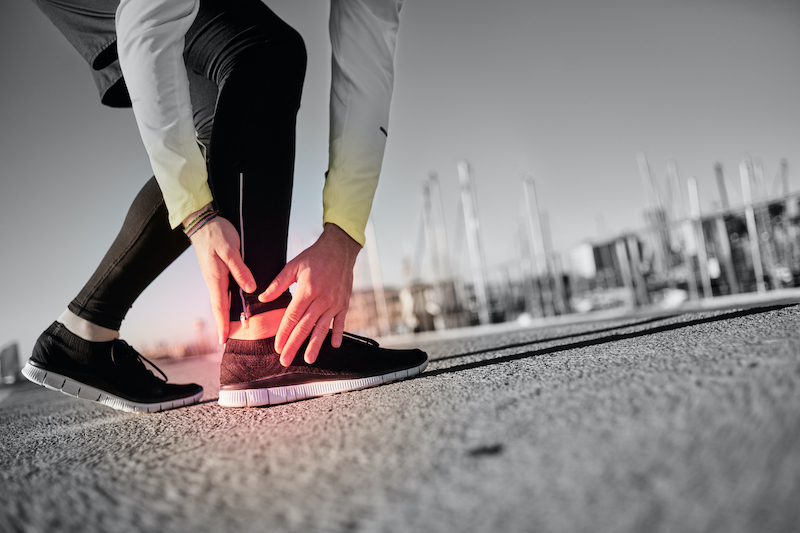As athletes, we spend a lot of time training and tending to pre-training, intra-training and post-training nutrition. One thing that sometimes falls through the cracks is a dedicated nutrition foundation and plan for recovery. It happens to the best of us, but missing out on key elements to recovery can lead to some uncomfortable outcomes. During this time of year when training for spring races starts to ramp up, you may find yourself increasing the frequency and intensity of your workouts.
As your training load and intensity increases, fatigue and muscle soreness often come with the territory. BUT, it shouldn’t consume your life. It’s not normal to feel that way day in and day out.
So, I’m sure you’re asking yourself “What can help to reduce muscle soreness and fatigue?”
Lifestyle and nutrition changes, of course!
Reduce muscle soreness and fatigue by looking at more than nutrition.
If you are new around here, something you should know about me is that I like to look beyond nutrition. I do this because I know how sleep, mood, stress and hunger relate to the big picture of your nutrition and wellness as an athlete. These elements are key to managing your performance. But, more importantly, they are key to living a balanced life that supports your goals while maintaining optimal health and happiness.
Helpful questions to ask yourself
If you are feeling fatigued, sore, and can’t seem to shake it, start by asking yourself these questions:
Am I eating enough?
And I mean truly eating enough and just not assuming. I say this because oftentimes, when I am working with a new client, they feel like they eat enough. However, their diet is high in food volume, but low in overall energy (calorie) intake. An example of this is eating salads, egg whites, chicken and oatmeal with little to no fats, carbohydrates or variety. There isn’t anything “wrong” with these foods, but calorically speaking, you might not be eating enough. If you are eating enough, the next step is to assess if your meals are balanced with carbohydrates, fats, proteins and colors. Ensuring adequate carbohydrates and protein will help manage glycogen stores and repair muscle tissue that’s damaged when exercising. A variety of nutrients are also essential in helping to manage inflammation and reduce muscle soreness. These include magnesium, zinc, vitamin C, omega 3’s.
Am I hydrating adequately?
Drinking at least ½ your body weight in ounces is a great place to start, but don’t forget to account for sweat loss. Aim for ~16-32oz fluid per hour of activity. (3) One of my favorite ways to ensure you are hydrating adequately is to use a water bottle with a known volume to make sure you are getting the amount of water you need. Decorating your bottle with stickers is a great way to make hydration fun, and having a bottle that you enjoy carrying around makes it more likely for you to achieve those hydration benchmarks.
Am I sleeping 7-9 hours per night?
Research shows 7-9 hours of sleep per night is a “sweet spot” to get into your deep sleep cycle (REM or rapid eye movement). (1) This allows for healthy, happy, hormone production, fostering an environment to better manage energy, immunity and muscle growth and repair. (2) Sleep is such an important aspect to our overall physical and mental health, not to mention performance. However, our busy lifestyles and technology make it challenging to get those Zzz’s. Good sleep hygiene, including a consistent bedtime routine, set (or as close to set as possible) sleep and wake times, relaxation techniques and avoiding blue lights for 30-60 minutes prior to bedtime can all help to create an optimal environment for accessing that sleepy sweet spot with ease. (14)
Am I using all resources available to me?
Connecting with a physical therapist, acupuncturist, massage therapist and/or chiropractor can be a huge help in your recovery toolbox. These professionals are all trained in techniques to assist you in maximizing your recovery. Additionally, oftentimes these providers are great resources to learn from for some DIY techniques to incorporate into your recovery routine.
Can supplements help?
If, after addressing all of the above, you still find yourself feeling like you aren’t recovering well, supplements can play a role! Keep in mind, supplements are not monitored or assessed for safety by the FDA. So, if you take them, there is a risk for contamination and for collegiate or professional athletes, a risk for banned substances.
If you are a collegiate athlete, the NCAA partners with Drug Free Sport Axis to provide athletes with educational resources to assist in making informed decisions about supplement use. It’s helpful for collegiate athletes to check with your team Registered Sports Dietitian and your Certified Athletic Trainer to access this resource and learn about the supplementation you are considering before potentially ingesting a banned substance and jeopardizing your eligibility. For other athletes and active people, choosing supplements that are NSF, BSCG, or Informed Choice approved ensures third party testing of these products, but is not a guarantee of safety. Always take time to talk with a Sports Dietitian to see if supplements are right for you as an athlete.
Supplements to reduce muscle soreness and inflammation
Once you have decided that supplementation is right for you, the next step is to identify which supplements may be helpful to reduce inflammation and muscle soreness. The following list comprises some useful supplements to do just that:
Anthocyanins & Curcumin
Both anthocyanins and curcumin have antioxidant properties, meaning they have the ability to reduce molecular (DNA) damage that comes along with exercise. (4)
Anthocyanins are found in foods such as blackcurrants, blackberries and blueberries, eggplant, red cabbage, cranberries and cherries. A food supplement form of anthocyanins is tart cherry juice. Research suggests tart cherry juice 8oz/day, twice per day or 1oz of tart cherry juice concentrate 2x/day can be useful to reduce muscle soreness.(5)
Curcuminoids are the antioxidant found in the spice turmeric. Curcumin has shown to reduce inflammatory markers with dosage of 1g/day for 8-12 weeks (6,7,8). You can also consider adding turmeric into your recipes for smoothies, oatmeal, curry, omelets, soups etc. Turmeric has an earthy, savory flavor and lends itself well to almost anything you add it onto. Plus, it imparts a golden color to your dish!
Collagen and “Pro Collagen” Nutrients
Collagen is a protein, and is the main component of the various connective tissues in the body—in other words, the material that holds the body together. Supplemental collagen has been researched in the sports nutrition world for its potential to produce collagen to aid in joint support. Some research has shown that taking ~15g vitamin-c enriched gelatin or hydrolyzed collagen 30-60 minutes prior to exercise may increase maximal uptake of amino acids for collagen synthesis and support our joints.(9,10)
If you choose to supplement with hydrolyzed collagen, choosing a supplement that has vitamin C included or consuming it with a vitamin C rich food, like an orange is important. That’s because vitamin C is a supporter of collagen synthesis, and is thought to amplify the absorption of the supplement. Studies showing benefits to joint health are relatively small, and as with many other supplements as well, I believe that more research is needed in this area to generalize findings. However, current results are promising. In addition to collagen supplementation, there are “Pro Collagen” nutrients that promote collagen synthesis including vitamin C, zinc, and copper. Food sources include fruits, whole grains, dairy, nuts, seeds, beans, meat and leafy greens.
Creatine
We consume creatine through food – milk, meats and seafood, to be specific. We have the ability to store creatine in our skeletal muscle, brain and liver. Creatine, in the world of sports nutrition, is known to give a “quick burst” of energy and strength during short, high-intensity exercise (such as strength training), but there is also research to support recovery from and adaptation to exercise. Creatine is thought to have this effect by stimulating “growth factors” – which is a fancy term for stimulating cell growth, inflammation, repair. Creatine is beneficial to not only strength athletes, but also endurance and multisport/recreational athletes. Creatine mono-hydrate is an effective and cost-friendly option. You can choose to do a “loading phase” by taking 20g/day for 5 days. However, taking 3-5g per day can achieve the same goal. (11,12)
The Omega’s
You may have heard of Omega 3 and 6 fatty acids (FA’s). Omega 3’s are found in fish, nuts and seeds (walnuts, chia, flax and hemp seeds), while omega 6’s are found in safflower oil, sunflower oil, corn oil, soybean oil, sunflower seeds, and pumpkin seeds. Each category of Omegas are important to health. However, for optimal health, it is beneficial to focus on improving the ratio of omega 6 FA’s to omega 3 FA’s.
High omega 6 to low omega 3 intakes have been linked to increased inflammation (12-14). This does not mean eliminating all omega 6 from your diet. Rather, finding a balance between the two through adding variety to your fat intake. Omega 3’s from fish (eicosapentaenoic acid or EPA, and docosahexaenoic acid or DHA) are consumed in smaller amounts for many adults, with more substantial amounts coming plant sources alpha-linolenic acid (ALA), including nuts and seeds. (15) ALA is considered an essential nutrient, so guidelines have been established for ALA, but not currently for EPA and DHA. EPA and DHA are not considered essential, as ALA can convert to EPA and DHA. However, the conversation rate is quite low. While certain health organizations have established EPA and DHA recommendations(16,17), the Dietary Guidelines for Americans suggests aiming to eat 2-3 servings of fatty fish, such as salmon. This equates to roughly 250-500mg of combined EPA and DHA to provide heart-health benefits.(18)
Research has shown a potential benefit of omega 3 FA’s to reduce muscle soreness in those who are not regular fish eaters and/or those who aren’t physically active. This also may be beneficial to trained athletes, but more research is needed on the amounts that would be required to have this benefit.(12-14) My advice would be to aim for 2 servings of fatty fish, such as salmon, twice per week to meet omega 3 needs. If this is difficult for you or you do not enjoy fish, supplementation to consume adequate omega 3 could be beneficial. For an athlete, some research suggests upwards of 2-3g (2000-3000mg) EPA and DHA may be beneficial to reduce inflammation and muscle soreness. (12-14).
If you are struggling with chronic fatigue and recurring injury, it’s time to take a look at your nutrition and see what you can do to feel your best. While the above information is a useful scaffold to begin to structure your questions around your potential supplementation needs, it in no way is a stand in for consultation with a professional who can guide you on your personal needs for optimizing recovery through supplementation. Feel free to set up a discovery call so we can discuss how to address this together. Or, join my upcoming Fuel Your Foundation program starting 1/25/22!
References:
- Waterhouse J, Atkinson G, Edwards B, Reilly T. The role of a short post-lunch nap in improving cognitive, motor, and sprint performance in participants with partial sleep deprivation. J Sports Sci. 2007 Dec;25(14):1557-66. doi: 10.1080/02640410701244983. PMID: 17852691.
- Doherty R, Madigan S, Warrington G, Ellis J. Sleep and Nutrition Interactions: Implications for Athletes. Nutrients. 2019 Apr 11;11(4):822. doi: 10.3390/nu11040822. PMID: 30979048; PMCID: PMC6520871.
https://www.usada.org/athletes/substances/nutrition/fluids-and-hydration/ - Mason SA, Trewin AJ, Parker L, Wadley GD. Antioxidant supplements and endurance exercise: Current evidence and mechanistic insights. Redox Biol. 2020 Aug;35:101471. doi: 10.1016/j.redox.2020.101471. Epub 2020 Feb 20. PMID: 32127289; PMCID: PMC7284926.
- Vitale KC, Hueglin S, Broad E. Tart Cherry Juice in Athletes: A Literature Review and Commentary. Curr Sports Med Rep. 2017 Jul/Aug;16(4):230-239. doi: 10.1249/JSR.0000000000000385. PMID: 28696985.
- Daily JW, Yang M, Park S. Efficacy of Turmeric Extracts and Curcumin for Alleviating the Symptoms of Joint Arthritis: A Systematic Review and Meta-Analysis of Randomized Clinical Trials. J Med Food. 2016;19(8):717-729. doi:10.1089/jmf.2016.3705
- Wang Fang, Yasaman Nasir, The effect of curcumin supplementation on recovery following exercise‐induced muscle damage and delayed‐onset muscle soreness: A systematic review and meta‐analysis of randomized controlled trials, Phytotherapy Research, 10.1002/ptr.6912, 35, 4, (1768-1781), (2020).
- Takahashi M, Suzuki K, Kim HK, Otsuka Y, Imaizumi A, Miyashita M, Sakamoto S. Effects of curcumin supplementation on exercise-induced oxidative stress in humans. Int J Sports Med. 2014 Jun;35(6):469-75. doi: 10.1055/s-0033-1357185. Epub 2013 Oct 28. PMID: 24165958.
- Clark KL, Sebastianelli W, Flechsenhar KR, et al. 24-Week study on the use of collagen hydrolysate as a dietary supplement in athletes with activity-related joint pain. Curr Med Res Opin. 2008;24(5):1485-1496. doi:10.1185/030079908×291967
- Shaw G, Lee-Barthel A, Ross ML, Wang B, Baar K. Vitamin C-enriched gelatin supplementation before intermittent activity augments collagen synthesis. Am Clin Nutr. 2017;105(1):136-143. doi:10.3945/ajcn.116.138594
- Smith-Ryan AE, Cabre HE, Eckerson JM, Candow DG. Creatine Supplementation in Women’s Health: A Lifespan Perspective. Nutrients. 2021;13(3):877. Published 2021 Mar 8. doi:10.3390/nu13030877
- Rawson ES, Miles MP, Larson-Meyer DE. Dietary Supplements for Health, Adaptation, and Recovery in Athletes. Int J Sport Nutr Exerc Metab. 2018 Mar 1;28(2):188-199. doi: 10.1123/ijsnem.2017-0340. Epub 2018 Feb 19. PMID: 29345167.
- Philpott JD, Witard OC, Galloway SDR. Applications of omega-3 polyunsaturated fatty acid supplementation for sport performance. Res Sports Med. 2019;27(2):219-237. doi:10.1080/15438627.2018.1550401
- Gammone MA, Riccioni G, Parrinello G, D’Orazio N. Omega-3 Polyunsaturated Fatty Acids: Benefits and Endpoints in Sport. Nutrients. 2018;11(1):46. Published 2018 Dec 27. doi:10.3390/nu11010046
- National Center for Chronic Disease Prevention and Health Promotion, Division of Population Health. (2016, July 15). CDC – Sleep Hygiene Tips – Sleep and Sleep Disorders. Retrieved January 9, 2022, from https://www.cdc.gov/sleep/about_sleep/sleep_hygiene.html
- U.S. Department of Agriculture, Agricultural Research Service. What we eat in America, 2011-2012.
 2015
2015 - https://efsa.onlinelibrary.wiley.com/doi/abs/10.2903/j.efsa.2012.2815
- https://www.heart.org/en/healthy-living/healthy-eating/eat-smart/fats/fish-and-omega-3-fatty-acids
- https://ods.od.nih.gov/factsheets/Omega3FattyAcids-HealthProfessional/#en5






